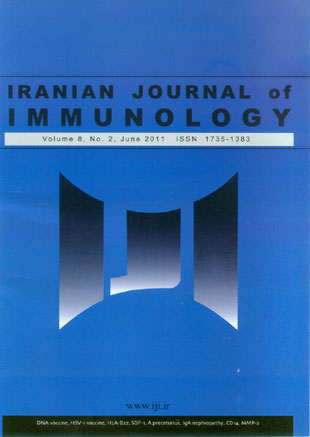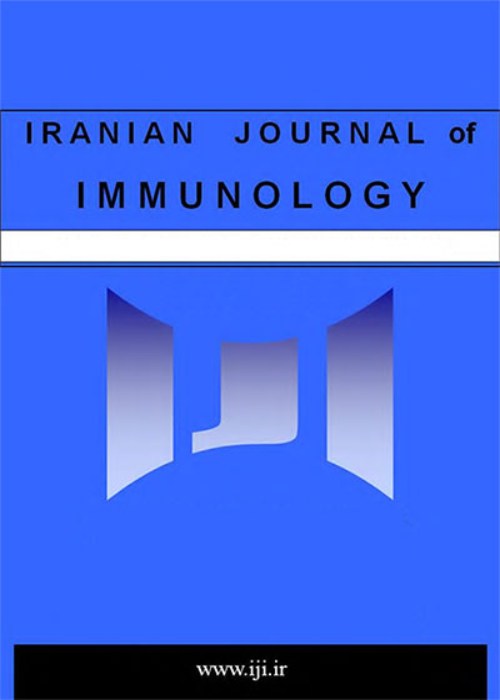فهرست مطالب

Iranian journal of immunology
Volume:8 Issue: 2, Spring 2011
- تاریخ انتشار: 1390/04/06
- تعداد عناوین: 8
-
-
Pages 65-75BackgroundVaccines capable of controlling tumor virus based infections are found difficult to develop due to the consistence latent infection in the host. DNA vaccines are attractive tools for the development of HPV vaccines and inducing antigen-pecific immunity owing to the stability, simplicity of delivery, safety and cost effectiveness. However, there is a need to increase their potency by procedures such as using HSP70 gene as an adjuvant.ObjectiveTo evaluate a DNA vaccine containing HPV16 truncated E7 C-terminal cytotoxic T-lymphocyte epitopes linked to HSP70 gene (HSP70-tE7) in an animal model.MethodsMice were immunized with the plasmid DNA after pre-treatment with cardiotoxin. The splenocytes of immunized mice were then tested for CTL activity by detecting the apoptosis and necrosis in target cells, cytokine production by ELISA, CD4 and CD8 frequencies by flow cytometry, and lymphocyte stimulation by MTT assay.ResultsThe recombinant expression vector was able to elicit immune responses close to that of full length E7 complete gene. Although the use of a small part of a target antigen can induce immune responses equivalent to the full length antigen, it fails to elicit statistically significant stronger immune responses when fused with HSP70 compared to the complete E7 gene alone.ConclusionThe potent immunogenicity of HPV16 E7 was preserved in the HSP70-tE7 vaccine and may represent a target of choice for the therapeutic vaccination strategies. However, to improve the immunogenicity polytope DNA vaccines which elicit multiple effector and memory CTL responses should be considered in future studies of DNA-based cancer vaccines.
-
Pages 76-84BackgroundStudies on efficacy of various vaccines that prevent or reduce the primary and recurrent HSV-1 infection have demonstrated the importance of cellular immunity for protection against the infection. We previously used DNA vaccination to induce cellular immunity against HSV-1 infection in mice.ObjectiveThe aim of our study was to evaluate the effect of LIGHT; a member of TNF super family, on the kinetic of CTL response induced by HSV-1 glycoprotein B based DNA vaccine.MethodsUsing a granzyme B ELISA for detection and analysis of CD8+ T cells, CTL activity was determined in the spleen of BALB/c mice at various time points after primary and booster dose of vaccination. The kinetics of CTL response to primary and secondary HSV-1 infection and DNA vaccination were compared to those induced by DNA vaccination in combination with LIGHT adjuvant in the present study.ResultsIn primary and secondary immunization, the CTL activity inthe HSV injected group peaked 7 days and 12 hours post immunization, respectively. After 5 days, LIGHT could neither accelerate the CTL response compared to DNA vaccination alone nor could enhance the CTL activity in the primary and the first peak of memory response, the amount of granzyme B induced by the LIGHT containing vaccine was significantly higher than that induced by the vaccine without the adjuvant.ConclusionAlthough LIGHT enhances the cellular response in the booster dose of vaccination, it does not accelerate the CTL response.
-
Pages 85-89BackgroundUveitis refers to diseases characterized by intraocular inflammation of the uveal tract. Anterior uveitis is a common ocular disease characterized by inflammation of the iris and the ciliary body.ObjectivesTo establish the frequency of HLA-B27-positive uveitis in Asian Indian population, study their clinical profile and compare it with other reports in literature.MethodsWe retrospectively reviewed medical data of 89 patients of uveitisreferred for HLA B27 typing with predominantly ocular symptoms during the period fromApril 2006-October 2010. All patients were tested for complete blood count, erythrocytesedimentation rate, infectious diseases serology, HLA-B27 typing, and prepared radiographs of the sacroiliac joints and lumbar spine if required.ResultsThe HLA-B27 positive rate was 56.2% among patients and 3% for control samples. Most of the patients were in the age group of 41-50 years with a male predominance.ConclusionsHLA-B27 was seen to be associated with acute anterior uveitis in Asian Indian males and the test is important for confirmation of diagnosis, prognostication and also for planning the treatment.
-
Pages 90-95BackgroundMyasthenia gravis (MG) is the most common disorder of neuromuscular junction in which autoantibodies develop against nicotinic acetylcholine receptor for unknown reasons. The association of immunomodulator genes with different autoimmune disease has been studied in recent years.ObjectiveThe aim of this study was to investigate correlation between a genetic variation in Stromal Cell Derived Factor-1 (SDF1) and susceptibility to MG in an Iranian population.MethodsGenotyping of SDF1 at position 801 G/A was performed by Polymerase Chain Reaction-Restriction Length Polymorphism (PCRRFLP) in 87 patients with confirmed myasthenia gravis and 261 normal control subjects.ResultsNo statistically significant differences were observed in the frequencies of genotypes and alleles between patients and controls (p>0.05). Furthermore, no significant differences in the genotype distribution were found between the cases with different stages (p>0.05).ConclusionOur data suggest that the SDF1 gene polymorphism at position 801G/A is not associated with myasthenia gravis.
-
Pages 96-103BackgroundVarious compounds of plant origin have been widely investigated since ancient times for their possible immunomodulatory properties as well as for the treatment of a wide range of diseases.ObjectiveTo study the immunomodulatory functions of the aqueous extract of the seeds of Abrus precatorius commonly known as Indian liquorice (Fabaceae), a medicinal plant native to central India.MethodsSwiss albino mice were intraperitoneally treated with three doses (0.75, 1.25 and 2.5 μg/kg b.w.) of extract for 7 days. Relative organ weight, delayed type hypersensitivity (DTH) response, haemagglutination titre (HT) and Phagocytic index (PI) were studied in various groups of animals.ResultsThe results showed no significant difference in relative organ weight of spleen, liver, thymus and kidney in various groups of animals. Treatment of rats with increasing concentrations of the extract decreased the footpad thickness indicating a dose related inhibitory effect of the extract on delayed type hypersensitivity. In the HT test, the plant extract showed a suppressive effect at all doses, and these changes were significant as the dose increased. Phagocytic index was also increased in a dose dependent manner.ConclusionThe reduction of antibody titre, delayed type hypersensitivity response and the increase in phagocytic index indicates that Abrus precatorius has an inhibitory effect on the immune functions in mice.
-
Pages 104-110BackgroundIgA nephropathy, a prevalent disease in Asia, is considered the main cause of end stage renal disease among primary glomerular disease.ObjectiveTo determine the frequency of different clinical, histopathological and immunofluorescent characteristics of IgA nephropathy.MethodsRenal biopsies of 376 patients were received for immunofluorescent and for histopathological studies. Biopsies were stained with fluorescene isothyocyanate (FITC) labeled antibodies against IgG, IgA, IgM, C3, C4 and fibrinogen for fluorescent microscopy. For histopathological examination, the specimens were stained withhematoxylin and eosin, periodic acid schiff and methanamine silver stains for light microscopy.ResultsIgA nephropathy was diagnosed in 39 cases (10.4%) with a mean age 31.5 years and a male to female ratio of 2.8:1. The disease was observed in 11(29.7%) patients aged 21-30 years, followed by 8 patients (21.6%) aged 11-20 years group. Nephrotic range proteinuria was the most common laboratory finding which was detected in 11 patients (37%). Mesangioproliferative glomerulonephritis was the most common histopathological finding which was found in 7 patients (35%). IgA with other immunoglobulins and complements were deposited in 28 specimens (71.8%) as detected by immunofluorescence.ConclusionIgA nephropathy is common in young people and one third of it results in end stage renal disease. We suggest that Immunofluorescent assay can be considered for the conclusive diagnosis of IgA nephropathy in young patients presenting with proteinuria/hematuria.
-
Pages 111-119BackgroundPattern recognition receptors (PRRs) are the main sensors of pathogen and danger signals in innate immunity of which Toll Like Receptors (TLRs) are the most studied ones. The contribution of PRRs in cerebral inflammation induced by microbial infection, tissue damage and cancer has not extensively been addressed so far. Glioma is the most common tumor of the central nervous system and glioblastomas are the most common and most malignant primary brain tumors.ObjectiveThe objectives of the present study were to investigate the expression of several PRRs including TLR2, TLR4, MyD88 and CD14 transcripts in human glioblastoma cell line U87 MG and compare their expression level with peripheral blood mononuclear cells (PBMC) obtained from healthy individuals.MethodsTouchdown PCR (TD-PCR) and Real-time quantitative PCR (qPCR) were applied to detect and quantify the expression level of TLR2, TLR4, MyD88 and CD14 transcript in U87 MG cell line and (PBMC) of healthy individuals.ResultsAccording to our results, human glioblastoma cell line U87 MG expresses TLR2, TLR4, MyD88 and CD14 transcripts in TDPCR. Moreover, the quantification of the expression of these genes revealed a highly significant down-regulation of CD14 and a slight up-regulation of TLR2 transcripts as compared to PBMC of healthy individuals.ConclusionThe lower expression level of CD14 in human glioblastoma cell line, might have a potential implication for CD14 mediated cerebral pathology.


